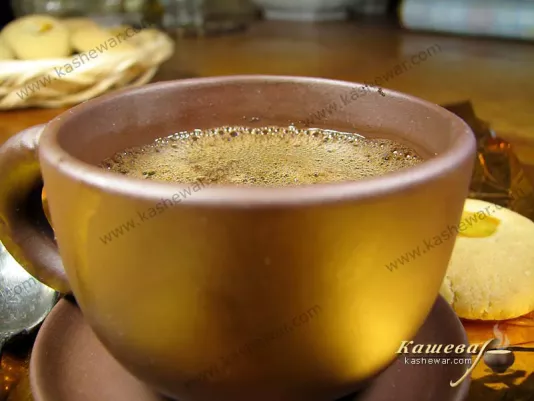Pumpkin Latte
Pumpkin latte is an American recipe, the famous latte from Starbucks.

Espresso coffee is both a complex and simple ingredient, where precision is crucial. I always feel that true flavor is born not only in the beans but in the moment they open up. When the grinder works evenly and the air fills with the scent of nuts, caramel, or cocoa, I know the beans are coming alive. Espresso reveals the full palette of coffee – from its rich body to the subtle aftertaste. Its power lies in minimalism: just a few milliliters, but each one deserves attention. I don’t see espresso as a quick drink, but as a concentrate of craftsmanship that demands calm and experience to reveal its true essence.
Every bean that gives birth to espresso coffee carries the story of the place where it was grown. For this drink, arabica or a blend with robusta is usually chosen – arabica provides aromatic depth, while robusta adds body and creamy foam. Over the years I’ve realized: the growing region shapes not only the flavor but also the texture of the drink. African beans have wine-like acidity and a light berry freshness, Latin American ones – a soft nutty-chocolate base, Asian – an earthy depth. But most important is the roast quality: too light makes espresso sharp, too dark – bitter. I always seek balance, when oils just begin to rise to the surface, creating a sheen, and the aroma is even, without smokiness. Freshness of the beans is also critical: a few weeks after roasting, coffee loses part of its volatile compounds, so I store it airtight, away from sunlight and moisture. This approach reveals the true essence of espresso – the harmony of bean, warmth, and air.
Finely ground espresso coffee looks like silky powder, yet even the smallest change in grind can alter everything. I always feel the difference by touch: when the grind is too coarse, the water passes too quickly, not extracting enough flavor; if it’s too fine – the flow slows down, and the coffee turns bitter. The balance between pressure and grind defines the density and aroma. Water also has its own character – its mineral content affects extraction. Too soft gives a flat taste, too hard – adds metallic notes. In my practice, I choose medium-hard water so the coffee stays clean but not bodyless. The way the water heats also matters: it should never boil, only be hot enough to release aromatic oils without burning them. Espresso is a precise balance between water flow and coffee resistance, between temperature and contact time.
The aroma of espresso is its signature. I can distinguish dozens of shades: from caramel and dark chocolate to a light citrus note. Each profile arises from the combination of variety, roast, humidity, and time. The texture of the drink is thick, almost velvety. On the surface forms a crema – a nut-colored foam that lasts for several minutes. It’s not just decoration: within it concentrate the essential oils and compounds that create the aftertaste. In my experience, perfect crema is always even, without bubbles or pale spots. Its aroma is warm, rich, not smoky. When the coffee has cooled and its aroma hasn’t faded, I know the beans were of high quality. Espresso always has “body” – the sense of density that lingers after a sip. It’s a sign of proper extraction, where neither water nor coffee dominates, but they work in harmony.
Despite its self-sufficiency, espresso coffee pairs beautifully with other flavors. I often use it as an accent in desserts – tiramisu, mousses, chocolate creams. Its bitterness balances sweetness, while vanilla and cocoa enhance its aroma. With milk, espresso gains softness, forming the base for cappuccino or latte. In my experience, it’s important not to overdo it: too much milk dulls the coffee’s character, while a small amount highlights its depth. Sugar should be added carefully – it must not replace the taste, only emphasize it. I also enjoy pairing it with cinnamon or nutmeg – they add warmth but don’t change the drink’s essence. In cooking, espresso acts as a natural enhancer for chocolate, giving desserts a lasting aroma. Its versatility lies in the fact that even in a drop you can find harmony with any ingredient that doesn’t try to take the lead.
Freshness of espresso coffee is its most valuable trait, and the easiest to lose. I always recommend buying beans in small portions, storing them in a tightly sealed container. Light, moisture, and temperature changes are the main enemies of aroma. If beans stay open even for a day, they lose volatile compounds, and the taste becomes flat. Ground coffee retains its aroma even less, so I grind it only right before brewing. Over the years I’ve realized: espresso’s stability depends not on the amount of coffee, but on its care. Even the most expensive beans won’t save a drink if stored improperly. For longer use, I sometimes vacuum-seal the beans or keep them in a cool place, but always let them “rest” at room temperature before grinding. This allows the aromas to recover. Espresso is not about chance: there are no small details in it, and attention to these details defines whether every cup will truly be alive.